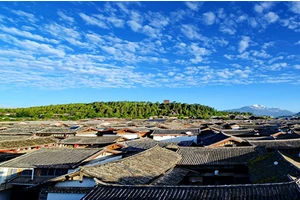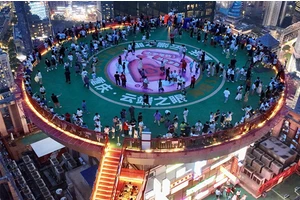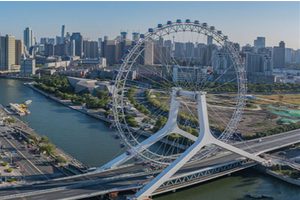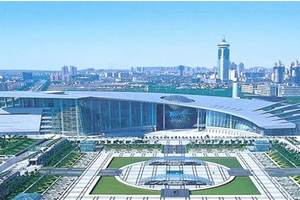Louguan travel
Zhao Gongming God of Wealth Cultural Scenic Area, as the hometown of Zhao Gongming, the true God of Wealth in China, and the center of historical inheritance, is his ancestral temple, which has a profound cultural heritage of Han and Tang Dynasties and has enjoyed the reputation of "the first God of Wealth in China, and Kyushu has no two blessed places" since the Ming and Qing Dynasties. This scenic spot, covering an area of about 531 mu, takes the rebuilt hometown of the god of wealth as the core, and integrates folk culture such as legends of gods and drum music of Jixian, aiming at creating a root-seeking pilgrimage tourism project integrating blessing and entertainment. The planning of the scenic spot is ingenious. The theme of the scenic spot is the Four Waters Guitang and the Five Fortunes, and the Three Fortunes Temple is the core, including the Blessing Hall, the Financial Temple and the Sanxiao Temple. There are some temples and small temples around the scenic spot, which are dedicated to Mazu, Wong Tai Sin, Guan Yu and many other gods of wealth, forming a complete exhibition park of folk auspicious and blessed gods.
Located in the hometown of the God of Wealth in Zhaodai Village, Jixian Town, zhouzhi county, Shaanxi Province, there is a Sanjincai Temple in the scenic spot, in which the Blessing Hall is the front hall, named after the Blessing God of Wealth, which means giving blessings to the world. Mazu Hall is located in the southwest of the Blessing Hall, showing the widely worshipped Mazu culture. The Red Pine Hall is dedicated to Wong Tai Sin, and the buildings on the southeast side show Wong Tai Sin's beliefs and health knowledge in detail. The Temple of Finance is a core building, 34 meters high, with a cultural exhibition area and a commodity store. The Guandi Temple and the National Protection Hall are dedicated to Wu Caishen Guan Yu and the God of Wealth, respectively, while Sanxiao Hall is the back hall dedicated to Zhao Gongming's three sisters. The Hall of Lucky Fortune and the Hall of Treasure show the God of Wealth and the culture of the stars respectively. The ancestral hall of Zhao is the place where the descendants of Zhao seek their roots, while the pavilion of Wen is located in the west of the park, which means "asking about the view of the building". Louguan Backstreet is a commercial street full of folk customs, selling handicrafts, local products and catering, which adds interest to the tour.
There are many tourist attractions in Louguan Town, and Louguantai, a holy place of Taoism, has ancient architectural complexes such as lecture platform, sutra depository, Yangtianchi, Qizhen Pavilion, Huilingguan and Yuhua Temple. Lao Tzu sits in the west tower of the land of transformation, and there are Lao Tzu's tombs. There are Louguantai National Forest Park, Tayu Village Daqin Temple Tangta (national key cultural relics protection unit and world ancient architectural heritage; Daqin religion was introduced into China in the Tang Dynasty as the earliest Catholic predecessor, lavender manor and other scenic spots.
Lecture platform
It is said that the platform is the central building complex of Louguantai. According to legend, Laozi gave lectures here. It was built in the second year of Tang Wude (619) and rebuilt in the eighth year of Yuan Taizong (1236). It is said that it is surrounded by Wanfeng in Tainan, surrounded on three sides, and the ruins of Zhou and Qin Dynasties are vividly present. It covers an area of 9,432 square meters, sitting north to south, and there are mountain gates, old mountain gates and spiritual palaces from south to north.
Daqinsi
Daqin Temple is located in Tayu Village, 1.5km west of Louguantai. It is built on the mountain, with Qinling Mountains in the south and Weishui River in the north. Daqin Temple was the title of the Eastern Roman Empire in the Tang Dynasty, and it was one of the earliest temples established when Nestorianism, a branch of Christianity in the Eastern Roman Empire, was introduced into China. In the ninth year of Emperor Taizong's Zhenguan, Aroben, a missionary of Nestorianism in Daqin, didn't arrive in Chang 'an. Emperor Taizong allowed to build a temple to preach filial piety. Tang Suzong favored the missionary Ismail. In the first year of Zhide (756), an Nestorianism temple was established in Zhouzhi. In the second year of Tang Dezong Jianzhong (781), an Nestorianism tower was built in the temple, and the "China Monument Popular in Nestorianism in Daqin" was carved by the missionary Jing Jing Jing. After that, Nestorianism was stopped, and Buddhism
Concept of prolonging life
Yanshengguan is located under Hojusan, 2 kilometers west of Shuojingtai. It used to be an ancient view of the Tang Dynasty, surrounded by green hills like Dai and green fields like silk, quiet and quiet. Princess Yuzhen, the grandson of Wu Zetian and the daughter of Tang Ruizong, once practiced in the palace, taking Shi Zongxuan, presided over by Taiqing Taoist Temple of Chang 'an as her teacher. After Tang Xuanzong acceded to the throne, Shi Zongxuan was punished for echoing Princess Taiping. Although Princess Yuzhen was expensive as her younger sister, she was also suspected and forced to go hundreds of miles away. In the third year of Tianbao, the princess wrote to Xuanzong to voluntarily give up her name and all the property rents given by the emperor, asking for a ten-year extension of her life. The emperor followed her, and in the first year of Tang Yizong King's reign, she was given the concept of "prolonging her life", and the princess lived in seclusion here for 50 years.
female springs
Huanv Spring is located on the plateau of the remaining vein of Zhongnanshan Mountain, about 1 km west of the platform. It is named after two ancient well springs. The two springs are arranged in the north and south, with a distance of less than 1 meter. The diameters of the two springs are about 60 cm, and the depth of the spring is about 3 meters. The spring water is pure and sweet, refreshing, full of water and never exhausted. According to legend, Xu Jia, a disciple of Lao Zi, was a beautiful man. One day, Lao Zi and Xu Jia came here on a mountain tour. Lao Zi pulled auspicious grass and turned it into a gentle and graceful beauty to test Xu Jia's practice kung fu. Unexpectedly, Xu Jia's heart was budding, and Lao Zi was disappointed. He was angry and admonished by the immortal battle, and Er Quan poured out, hence the name "The Spring of Women".
Shangshanchi
Louguan said that there was a bagua-shaped pool in front of the Taishan Mountain, and the wall of the pool was full of water, and the bottom of the pool was full of spring water. There was a small pavilion next to the pool, and a monument in neutrality said "Shangshan Pool". According to legend, in the twentieth year of Yuan Shizu to Yuan Dynasty (1283), there were numerous deaths during the week. Lao Zi, a dream of Zhang Zhijian in Louguan Prison, said: There is spring water outside the mountain gate to cure the epidemic, and the Taoist priest who suffered from the water test proved to be effective. The news spread that patients from all directions came to take water to cure the epidemic, and a dangerous plague was quickly put out. Later, Zhao Mengfu, a great calligrapher with a bachelor's degree in Hanlin, visited Louguan and heard about this strange thing, so he wrote the book "On".
Alchemy furnace
In the south of the platform, a peak stands, reaching the sky. According to legend, this mountain was the place where Laozi and Yin Xi made an alchemy, hence the name "alchemy peak". During the apocalypse of the Ming Dynasty, Louguan Taoist Temple built a tower-shaped eight diagrams alchemy furnace at the top of the peak, which was like the meaning of Laozi's alchemy and became a scenic spot in Louguan.
phonolite
It is said that there is an octagonal stone mill in the back of the Xuandian Temple, which is rough and simple in texture and looks like nature and man-made. The clang of the buckle makes a metallic sound. Legend has it that Laozi came to Louguan to teach the method of alchemy and personally burned the elixir. At that time, all the facilities in his house were complete, except for a stone plate for grinding medicine, which must be the lingshi in the epoch-making era. Later, Laozi personally borrowed a stone left over from the The goddess patching the sky Palace, and later the Taoist priest moved it to the lecture platform, which was a treasure of the town, and tourists knocked on it to avoid disaster and get sick.
Ancient ginkgo tree
There is an ancient ginkgo tree in Zongsheng Palace in Louguantai, which is said to have been planted by Laozi himself. It is 2500 years old and has a circumference of 12 meters. The dragon is dry and covered with branches, and the crown is like a cottage. Although it has been burned by thousands of years of wind, rain, lightning and soldiers, the heart of the tree has been completely empty, and only half of the residual skin is in danger, but the crown is still green and leafy, and it is as rich as new.
Wenxian' gou
Wenxian ditch is located in Tainan, and its mouth is between the alchemy peak and Xianling mountain, with a depth of 8 kilometers. The ditch is winding and winding, and the winding path is secluded. In the meantime, Jingteng is lush, silver trees are green, streams are full of birds, waterfalls and springs are everywhere. In history, many noble heroes and immortals practiced here, so it was called "Wenxian Valley".
Xianlingshan
In Taitung and the east bank of Wenxiangou, a mountain is rising, the mountain is gentle and fantastic, and the whole mountain is hidden among lush bamboo trees. Autumn mountains are full of red leaves, colorful red columns and blue tiles, and clouds are lingering. It is said that at dawn in the nineteenth year of Tang Kaiyuan, Emperor Xuanzong dreamed that Lao Zi said that he was in the mountains more than 100 miles southwest of Chang' an, and he was sent to meet him quickly. Xuanzong immediately after waking up.
Lvzudong
Lv Zu Cave is located in Tainan, the eastern side of Wenxiangou, where bamboo trees gather and vines are mixed. Under the cave, there are often secluded valleys and blue clouds, and the Ran Ran is thin. In front of the cave, there is a flat land with a width of more than 20 meters. Standing on it, the breeze is refreshing, looking up and down, the blue cave is winding, the clear stream is gurgling, and the green hills are green.
Zongsheng palace
After the establishment of the Tang Dynasty by Tang Gaozu Li Yuan, in order to raise his younger brothers, pursue Laozi as a distant ancestor, and respect Taoism, Wu De spent three years, and ordered an imperial edict to expand the building view, which was completed in five years. The newly expanded area was vast, the scale was magnificent, the halls and pavilions were towering, the buildings were three different, colorful, and the golden walls shone brightly, and the mountains and rivers added color to it, and the sun and the moon added luster to it. He also went down to the marsh as the "Zongsheng Palace" to take Laozi, the ancestor and sage.
Jiulaobai
There are nine ancient cypresses in the ruins of Zongsheng Palace in Louguantai, which are called "nine old cypresses". Legend has it that the Golden Yuan and the Golden Yuan competed against each other, and the Louguantai was greatly damaged, and the temple was destroyed. The courtyard was deserted, and the Taoist priests fled away, and thieves frequently disturbed it. One day, the founder of Zhengyang left this place and fell asleep in the shade of the sacred palace. Suddenly, nine old people came to ask for an audience, saying that we were all Louguantaoists, and our ancestors were in decline for a long time, and there were local ruffians harassing us. We asked the founder to decide and wake up.
Three eagle cypress
There is an ancient cypress in the ruins of Zongsheng Palace in Louguantai. Although it has completely dried up, it stands between heaven and earth like cast iron and copper. What is even more amazing is that three goshawks with tung trees quietly stop among the branches, leading with their eyes tilted, which seems to be hopeful and vivid, which is incredible enough. Only thanks to the magic of nature, this amazing cypress tree is called "Three Eagle Cypress". Legend has it that in order to become immortal, three eagles stole the elixir of the great old gentleman, and after being discovered by the old gentleman, they fixed it on the branch with a spell and turned it into a body of wood and stone forever.
sanqing hall
Sanqing is the highest deity in Taoist immortal series. Legend has it that the Buddha's dharma bodies were Jade Qing Yuan Shi Tian Zun, Qing Qing Lingbao Tian Zun and Tai Qing Moral Tian Zun, known as "Sanqing" in the world. Sanqing's residence is Sanqing's territory, and since the beginning of the Yuan Dynasty, Tianzun lived in the Qing Dynasty in Luo Tian, Lingbao Tianzun lived in the Yu Yutian in the Qing Dynasty, and Moral Tianzun lived in the Tai Chi Heaven in the Tai Qing Dynasty. Sanqing has its own position, and Shengdeng Yuqing, Zhendeng Qingqing and Xiandeng Taiqing. Because Sanqing is the highest deity in Taoism, Sanqing Hall is the most lofty hall in Taoist temples.
Ziyun building
Yin Xi's house is called the view of grass building at the foot of Zhongnanshan Mountain, looking at the stars and looking at the air. When Yin Xi watched the celestial phenomena, he saw the purple gas coming from the east. Later, he derived such great events as "the encounter between the holy and the true, and the giving and receiving of the second classics". This building was called "Ziyun Building" one by one. Successive dynasties attached great importance to Ziyun Building, and successively added, modified and built it. In Yuan Dynasty, Zongsheng Palace was rebuilt and Ziyun Building was built again, and the second floor of Jingyang Baozhang was built around the vestibule of Ziyun Building, forming a magnificent building group structure, and this building was changed to "Ziyun Yanqing Building" to show that the building concept came from Laozi's purple spirit and Taoism flourished.
Laozi's tomb
On the west side of Jiuyukou, there is a Daling Mountain, where pine and bamboo are green and misty, which is very beautiful and different from other mountains. The description of "Going out from Nanshan to Gully, going north to Dalingxi, known as Laozi's Tomb" in the Notes on Shuijing by Li Daoyuan in the Northern Wei Dynasty is consistent with the local topography, hydrology and the names of Jiuyugou, Jiuyuhe and Daling Mountain, which is suitable for the Zhou Dynasty. Bi Yuan, a scholar in Qing Dynasty and governor of Shaanxi Province, carved a stone tablet at the foot of Daling Mountain.
Wulaodong
My old cave is a natural cave on the top of the Daling Mountain in the west tower. The word "My Old Cave" means "Encuo's Cave of Our Great Laozi". My old cave sits north to south, surrounded by mountains in the south, and Bijia Mountain in the south is towering like a screen. The dragons and tigers in the East and West Gangling are leaning on the side, and the peaks are guarding, just like the worship of the ministers in the Ninth Five-Year Plan and the opening of the hall in front of the cave. It is a flat and spacious mountain flat with towering smoke trees. The cave is not more than a foot wide, and the strange stones are embedded in the air. There is a tunnel on the right, which goes down more than three meters and turns to the west. In front of the cave, there is the "Rebuilding the Temple of My Old Cave" engraved in the Wanli of the Ming Dynasty for four years. The inscription contains "The skull of the holy skeleton is still there, and the jade box treasure is all there."
The Queen Mother's Palace
Wangmu Palace sits north to south on the small platform of the West Building, with magnificent temples, the Queen Mother of the West sitting solemnly, full of vigor and splendor, and colorful weather. In the south, there are Guandi Temple, Sanqing Hall, Dasheng Pavilion and the monument pavilion of Tao Te Ching. The halls and pavilions are small, exquisite, tortuous and well-arranged. Taitung meanders to the north on the Yuhe River, and the tidal flat sandwiched by water and mountains is steaming, which is caused by geothermal hot springs, commonly known as the "Queen Mother's washbasin". It is said that the jade face of the Queen Mother was washed out in the hot springs.
Taibaimiao
Taibai Temple is located in Machagou, about 1 km away from Xilouguan, between temples halfway up the mountain, with statues of Big Taibo, Second Taibo and Third Taibo. Legend has it that during the Shang Zhou period, Boyi and Shu Qi came to Xiqiao, and failed to persuade Wu Wang to stop fighting and support the people. They came to shouyangshan to collect EU and live in seclusion. They didn't eat Zhou Su and starved to death in the mountains. When Zhou Bo, a general of the DPRK, was ordered to search for them, he was deeply moved and died after hitting the mountain. Three of them were chased as Taibai deities (meaning "clear white jade pole") and set up temples for sacrifice. Three Taibao took turns to manage the mountains.
Dingkong temple
Dingkong Temple, formerly known as Bodhisattva Temple, was built in the early Sui Dynasty. The incense was flourishing in the Tang Dynasty. After Tang Wuzong banned Buddhism, the Bodhisattva Temple was destroyed. In the later Tang Dynasty, Dingkong Buddhist Temple was rebuilt, and Buddhism revived. Later generations called the rebuilt temple "Dingkong Temple". After several times of destruction, Dingkong Temple only has a site, which is located in the west of Xiping, the current Tuanbiao village.
Twelve halls
The Twelfth Hall is located in Tuanbiao Valley behind Dingkong Temple. It is said that in the last years of Sui Dynasty, the world was in chaos and the people were in poverty. A group of refugees came to the Bodhisattva Garden after being chased by bandits. However, because the temple was too small to accommodate these refugees, the temple host asked them to hide in Tuanbiao Valley behind the temple. When the bandits arrived at the mouth of the ditch, it suddenly became stormy and thunderous, and the bandits retreated, and the people were saved. It was said that Guanyin Bodhisattva appeared to protect all beings.
Lianhuatai
Lianhua Terrace is located in Huangchigou on the east bank of Heihe River. It is said that at the end of the Tang Dynasty, Huang Chao Rebels were stationed here to fight fiercely with the imperial court. The rebel army built a Guanyin Bodhisattva Temple inside the barracks, and carved a jade statue. After the Huang Chao rebel army sent troops to Chang 'an, the Bodhisattva Temple and the stone statue were destroyed by a flood. Later generations found a lotus throne of Guanyin Bodhisattva, and built a lotus flower terrace here, with a Guanyin statue built in it, to bless one side's peace.
Longwangmiao
Huangchi Natural Village, located in Tuanbiao Village, Louguan Town, is called the Black Dragon King. What's more, the dragon king statue has only one eye. According to legend, after the establishment of the Han Dynasty, Prime Minister Xiao He strongly recommended Chang 'an as the capital city, and Gaozu agreed to recruit civilian workers, collect materials and build the capital city. As a result, a large number of civilian workers drove into the Qinling Mountains to cut down wood. The craftsmen found a jujube pine with a length of 90 feet on the mountain, which was the most suitable for the nine purlins of the Golden Temple. When Xiao He learned about this, he asked the craftsmen to cut down the wood, but it was a problem to transport it. Since ancient times, Heihe River has been transported by water. However, due to the narrow bend of Heihe River, small pieces of wood are acceptable, and large pieces of wood cannot be transported. At this time, the black river dragon king showed his true self and rolled the wood vertically in the water and transported it out of the mountains with his dragon tail. Liu Bang's golden urn was built, but the Black River Dragon King made an eye blind by overexertion. Liu Bang personally sealed it in recognition of the Dragon King's achievements, and the Black River Dragon King did not drag the mill or drill holes.
Sanxiaodian
Sanxiao Temple is located in Yao Village, 5 kilometers west of Louguan Town. Sanxiao is said to be Yunxiao, Qiongxiao and Bixiao, the sisters of Zhao Gongming, the God of Wealth. Once she practiced for thousands of years, she was not only powerful, but also jade bone's ice muscles, graceful fairy figures, dark temples, bright eyes, bright light, handsome and heroic. Later, at the invitation of his elder brother Zhao Gongming, Sanxiao helped to resist the Zhou Dynasty, and put on a big show of the Yellow River array, which was broken by Zhou Bing. Sanxiao's fragrance sold her jade and her soul returned to the sky, and she was named the beauty-sending empress, and she attended the 20th meeting in the first month of each year.
Louzishan
Louzishan, also known as Shilouguan, is located 8 kilometers south of Wenxiangou, which is the junction of Houdongming Village and Qianjiuyu Village. Its mountain shape resembles a stone building that stands in the sky and is adjacent to Louguantai, so it is called "Shilouguan". According to records, during the Five Dynasties and the Northern Song Dynasty, Tan Qiao, a well-known Taoist scholar, lived in seclusion and practiced here. He became a teacher and friend with Chen Tuan, and wrote a book "Hua Shu", which was a pioneer of Taoism. His achievements were outstanding and he was listed as the "four sons of Taoism" in Louguan Taoist altar. At the same time, Li Qi, Lu Dongbing, Taoist Mayi and Chen Zhuan often come to this party. At the beginning of the Ming Dynasty, there were legends about the real dragon and Zhang Sanfeng's activities, which made the stone building view famous for a while, and gradually became silent at the end of the Ming Dynasty.
Yuxian bridge
Yuxian Bridge is located on the Jiuyu River in Dongling Mountain, Xilouguan. It was built in the Yuan Dynasty. It is said that some people met immortals such as Lv Dongbin and Zhong Hanli on this bridge. The bridge is 11 meters long and 3 meters wide. It was washed away by water in the 1960s and rebuilt in the 1980s.
baoguang temple
Baoguang Temple is located outside the north gate of Shangsanqing Village in Louguan Town. It is said that after the completion of the temple, it shines golden, and the surrounding villagers can see it with their own eyes. Every year, the Dojo is widely opened on the 23rd day of the first month.
dongyue temple
Dongyue Temple is located in the southeast of Dayu Village, Louguan Town. The main sacrifice is Huang Feihu, the Emperor of Dongyue, who commemorates his great achievements in helping the Zhou Dynasty. The temple fair day is on the eighth day of March every year, with drama performance, paper binding and social fire parade.
Lou Guantai National Forest Park
Louguantai National Forest Park is located in Louguan Town, zhouzhi county, Shaanxi Province, at the northern foot of the western Qinling Mountains. It is 70 kilometers away from the ancient city of Xi 'an in the east, and is connected with Longhai Railway, Xibao Expressway and National Highway 108. Covering an area of 6.46 square kilometers, the management office is located in Louguantai. The forest landscape here is very beautiful, with towering ancient trees and green mountains and waters. Louguantai Forest Park, founded in 1982, is one of the 12 national forest parks first approved by the Ministry of Forestry and the first forest park in Northwest China. In 1992, it was designated as a national level by the Ministry of Forestry, and in 1997, it was rated as "one of the top ten landscapes in Xi 'an".
Louguantai Forest Park covers a total area of 27,500 hectares. It is planned to have four gardens, namely East Louguan, West Louguan, Tianyuhe and shouyangshan, 12 scenic spots and more than 200 scenic spots. It is a tourist attraction with excellent integration of humanity, nature and forest landscape. There are 40 Lixia Yixiantian, Bison River Waterfall, Wangzigou Ancient Karst Cave, shouyangshan colorful stone, Yangtianchi, Dongbin Spring, Longwangtan Scenic Resort and other natural landscapes. There are bald mountain meadow, alpine spruce fir, rhododendron natural forest, thousands of acres of artificial bamboo forest and other forest landscapes. The vertical band spectrum is obvious, and the seasonal changes are myriad. There are many cultural landscapes such as the platform, the alchemy peak, the Daling Mountain, my old cave, Hong Hai cave, Longwangtan Scenic Resort, shouyangshan and Guanyin Temple.






